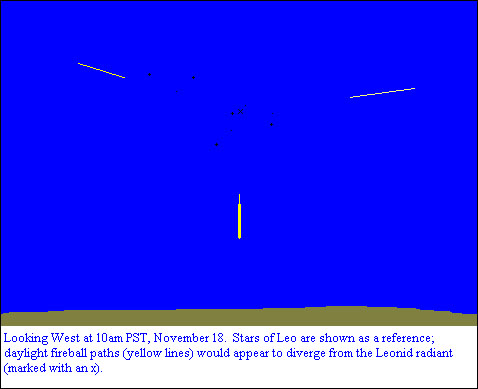Daylight Fireballs from the 2001 Leonids?
As the Leonid maximum approaches, Pacific Northwest observers look forward to a possible storm, predicted to occur in the hours around 2am PST on November 18. An even more prolific display is expected around 10am PST, in daylight and seemingly out of reach for US observers. Ambitious astronomers, however, should be alert to the possibility of daylight fireballs from this second storm.
OBSERVING CIRCUMSTANCES
As profiled in the November issue of Sky and Telescope, the two foremost teams of Leonid forecasters both predict a major storm event, peaking between about 9:20am and 10:20am PST on November 18. This storm would be caused by particles ejected from the parent comet in 1699 and 1866, and is forecast to produce a ZHR (zenithal hourly rate) of around 8500.
At 10am PST, the Leonid radiant is ~40 degrees high in the southwestern sky. The ZHR equation says that, based on this elevation, an observer in dark skies might expect to see 64% of the ZHR. The correction for limiting magnitude in daylight is, of course, huge and uncertain. Venus at magnitude ~-4 is visible in clear daylight sky if you know just where to look, so perhaps -4 is a good value to throw out for limiting magnitude. In this case, if the Leonids are assumed to have a brightness profile characteristic of shower meteors, the correction would be ZHR/15000, for an average observed rate of less than 1/hour. A more optimistic brightness profile might give a predicted rate of several Leonids/hour. In the end, the conventional formula for ZHR may not hold true for daylight observations, which involve a very few bright objects. Several daylight fireballs were reported in Japan during the 1999 storm, even though observers in dark skies noted the shower was deficient in bright meteors.
HOW TO OBSERVE
The actual rates of Leonid fireballs are uncertain. So, too, are the best daylight observing procedures, as warnings of potential outbursts have just recently "come of age." Since the Sun will be in the southeast, you may wish to face directly opposite the Sun. Blocking the Sun behind an obstruction such as a building, while keeping your visual field unobstructed, may be helpful. It is also possible that fireballs may be more visible in the "polarization zone," 90 degrees from the Sun. Whatever the outcome of daylight Leonid observations, they should be an interesting undertaking. The potential payoff is big: visually observing a meteor shower in broad daylight!


